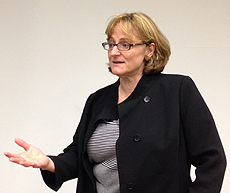Hidden gender bias still influences physics field
 |
| Yale University astrophysicist Meg Urry spoke about gender bias in science at the July 30 Fermilab Colloquium. Photo: Lauren Biron
|
Both men and women need to improve how they evaluate women in the sciences to help eliminate bias, says Meg Urry, who spoke at last week's Fermilab Colloquium. People of either gender fall victim to unconscious prejudices that affect who succeeds, particularly in physics.
"Less than 20 percent of the Ph.D.s in physics go to women," Urry noted, a figure that has barely crept up even while fields such as medicine have approached parity.
Urry, a professor at Yale University and president of the American Astronomical Society, unleashed a torrent of studies demonstrating bias during her talk, "Women in Physics: Why So Few? And How to Move Toward Normal."
In one example, letters of recommendation for men were more likely to include powerful adjectives and contain specifics, while those for women were often shorter, included hints of doubt or made explicit mention of gender.
Another study found that in jobs that were perceived as masculine, both men and women tended to award the position to the man even when the woman was the qualified individual.
Other data showed that women are less likely to be perceived as the leader in mixed-gender scenarios, Urry said. When small numbers of women are present, they can become an "other" that stands in for the whole gender, magnifying perceived mistakes and potentially confirming a bias that women are less proficient in physics.
"You need a large enough group that people stop thinking of them as the woman and start thinking of them as the scientist," Urry said.
Urry advised the many young women in the audience to own their ambition, prep their elevator speeches, get male allies who will stand up if female voices are ignored, practice confidence and network. Above all, she said, work hard, do interesting work, and don't be discouraged if things get rough.
Meanwhile, Urry said, leaders need to learn about bias, actively look for diverse candidates rather than wait for applications, mentor and prevalidate women, such as when introducing a speaker.
Urry worked hard to debunk the myth that hiring more women means lowering the bar for diversity's sake.
"When you hire a diverse group of scientists, you are improving your quality, not lowering your standards," Urry said, echoing sentiments from her lunchtime talk with 40 women. "We should be aspiring to diversity of thought to enrich science."
—Lauren Biron
|